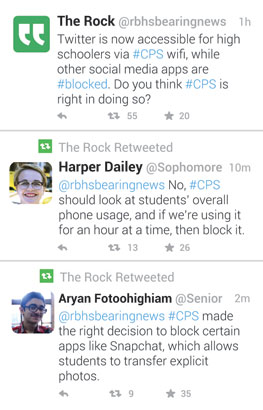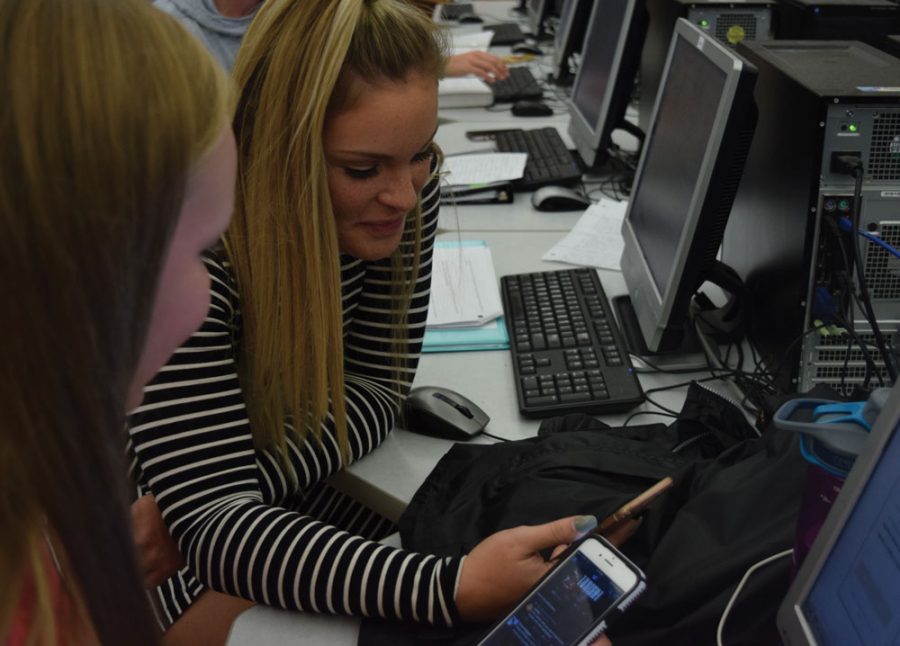District removes Twitter block on student Wi-Fi
Sophomore Chloe Peterson sits in her fourth hour World History class, her eyes drooping as she settles down at the end of a long day. She quietly sneaks out her phone, turns on her cellular data and taps on to Snapchat. Her teacher continues the lecture as she updates her story and scrolls through the filters.
“I check my phone about two times every class. I text people [and] go on Instagram and Snapchat,” Peterson said. “All the time I’m curious about what’s [happening on social media during class].”
Getting on social media during school may seem like an everyday occurrence in teenagers’ lives, but the simple act of doing so is quite contrary to the purpose of CPS’ private wifi. In fact, using a phone without connecting to wifi is the very thing that enables a student to surpass the firewall that blocks social media sites and apps from use.
CPS Director of Technology Services Chris Diggs explained that there are different social media apps blocked for elementary, middle and high school students. Twitter is the only app accessible for high schoolers on school-issued and personal devices connected to CPS wifi.
Applications such as Instagram, Snapchat, Facebook and Tumblr were banned during the 2015-16 school year and are still blocked. But as students bypass the school wifi, they also circumnavigate The Children’s Internet Protection Act (CIPA) that filters Internet access to sites deemed obscene or harmful to minors.
“[Social media] has always been blocked, even back when Facebook was pretty much the only social media site being used. It has only been within the last few years we unblocked it,” Diggs said. “The CPS District Technology Committee and our school district leaders all provide input regarding their assessment of the educational value provided by the [social media site under assessment.]”
While there are legal ramifications for a district under federal funding to decline the use of a internet firewall, media specialist Dennis Murphy said blocking social media is also a part of avoiding security breaches.

Murphy encounters students using social media at school every day. Because of this, sidestepping the CPS wifi doesn’t shock him.
“There is no doubt in my mind that most people get around anything they want to get around,” Murphy said. “That doesn’t surprise me at all.”
Although Peterson found a way to access her social media, she still sets limits for her social media usage while in class and finds the filters helpful for fending off distraction.
“I try to stay focused though I do give myself breaks when the teacher isn’t talking,” Peterson said. “High school students should have boundaries, though they’ll most likely break them anyways.”
Giving iPads to all students considered in new plan
Since Columbia Public Schools (CPS) introduced iPads three years ago, the district has tried different tactics, such as filtering social media, to tighten their control over them. After last year’s talks of initiating the CPS Personalized Learning Program, CPS administrators began talks to decide what device would be given to students. The new discussion for the program, also known as the 1:1 plan, is now in full swing.
The 1:1 ratio is similar to RBHS’ iPad accessibility for Advanced Placement (AP) students except that all students would have the opportunity to use a device.
The policy currently in place is not equal throughout all of CPS. According to the RBHS website, CPS issued iPad Minis to all of Battle High School (BHS) students during the 2016-17 school year. Likewise, CPS offered all full time sixth through eighth graders iPad Minis under the 1:1 plan. Meanwhile, AP students at Hickman High School (HHS) received an iPad Mini, similar to RBHS.
These circumstances beg the question: Why do different schools have different policies for iPad accessibility? Diggs said these inconsistencies in CPS are because of the still fluid and evolving conversation surrounding the 1:1 plan.
“We do expect the program to expand to other schools. It is our hope [that] all students can participate in our Personalized Learning Program,” Diggs said. “All students in all schools have access to laptops, desktops and tablets. We believe students need access to multiple types of tools and devices so the technology can align to the learning needs of our students and the instructional goals.”
As far as principal Dr. Jennifer Rukstad has heard, CPS has not determined the device for the 1:1 plan. Last year’s discussion among administrators debated whether the device used would be a laptop or an iPad. Although talks regarding the timeline of the plan have not been decided, Dr. Rukstad has hope for the 2017-18 school year.
“As far as I know, it is still in motion,” Dr. Rukstad said. “We haven’t heard much about it from the district level since the spring. I am not sure [of] the reason.”
While iPads seem to be CPS’s preference for enacting the 1:1 ratio for select schools and AP students, junior Hannah Potter uses her personal laptop for academic purposes more than she uses the school issued iPad.
“I think typing and functionality is a little bit better. [It has] a bigger screen [and] some of the functions run better than on iPads,” Potter said. “Usually all of my debate stuff and my evidence is on my laptop.”
Potter said she has seen other students with personal laptops function in a similar way to her; the more they use the laptop, the less need they see for the iPad.
“I haven’t seen a lot of kids really use their iPads in AP classes,” Potter said. “Some kids don’t even want to pick them up [from the media center] because if they have a laptop, they know they won’t use the iPad. I haven’t heard specific complaints, I just see them being used less and less.”
Despite the drawbacks associated with the iPads, Diggs said the step to integrate them into school was an attempt on CPS’s part to help teachers engage students in “challenging” lessons through the use of devices.
“The focus and conversation needs to change to be about what effective, engaging instruction should look like to best meet the needs of today’s students. The devices are simply tools. They do not cause good teaching; only good teachers can do that,” Diggs said. “Digital tools allow better accessibility to information and the up-to-date digital resources selected by our Curriculum Coordinators and teacher leaders.”













































































